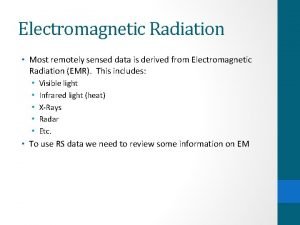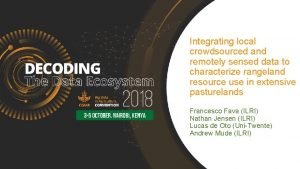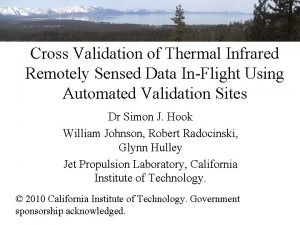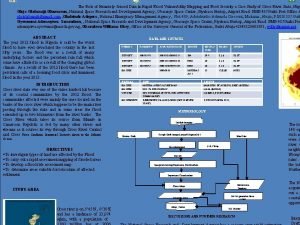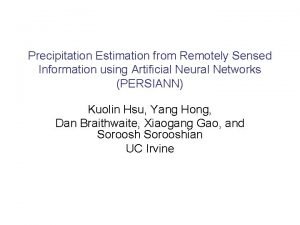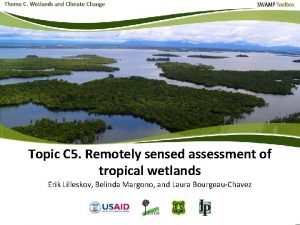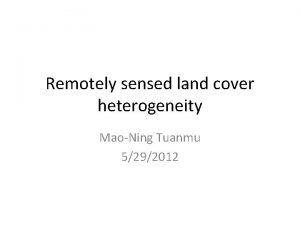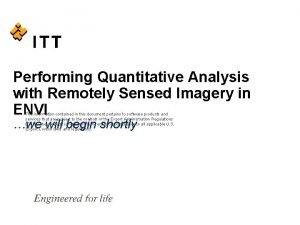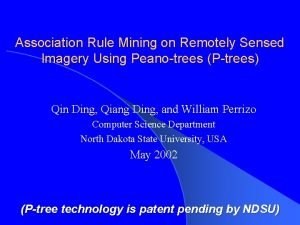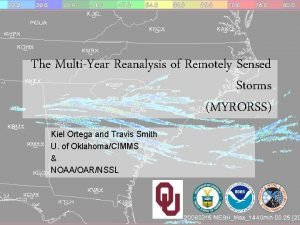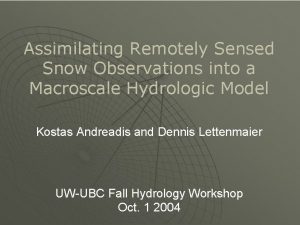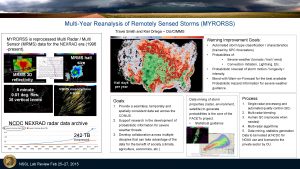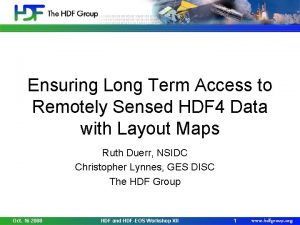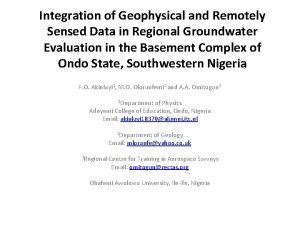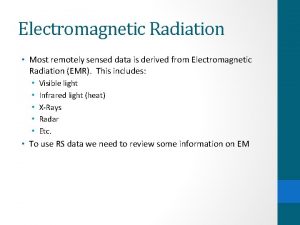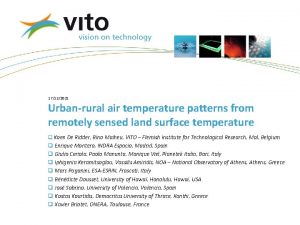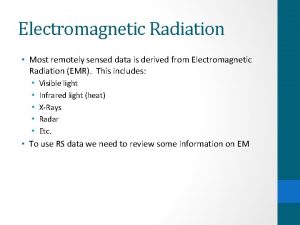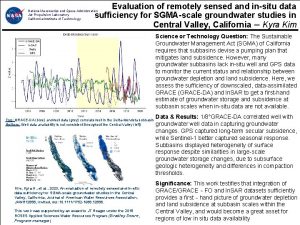Remotely sensed spatial dynamics of the Illex argentinus

























- Slides: 25

Remotely sensed spatial dynamics of the Illex argentinus fishery, Southwest Atlantic 西南大西洋遙測阿根廷魷漁業 時空動態之研究 Claire M. Waluda ∗, Huw J. Griffiths, Paul G. Rodhouse Fisheries Research 91 (2008) 196 -202 Reporter: 凌子雅

Introduction Atlantic Ocean 22°S 54°S Illex argentinus

Defence Meteorological Satellite Program-Operational Linescan System (DMSP-OLS) http: //www. daviddarling. info/encyclopedia/D/DMSP. html > 300 k. W

Objective Ø This work examines inter-annual variability in the distribution of the fishery over the 13 year period 1993 -2005. Ø The area occupied by the fleet is compared with variability in catches over the same period.

Materials and Methods 1. Data sources Ø DMSP-OLS data ( Defence Meteorological Satellite Program-Operational Linescan System data ) Ø Fishery data 2. Analyses Ø Presence of fishing lights over the Patagonian shelf Ø Inter-annual variability in the spatial distribution of fishery Ø Relationship between fished area and catch

DMSP-OLS data u. Period: January to August 1993 -2005 u. Time: 23: 00 - 03: 00 local time u. Region: the Patagonian Shelf, Southwest Atlantic u. Resolution: approximately 2. 7 km u. Images: 496 (five single-pass images per month) National Geophysical Data Center (NGDC) Geographical Information System (GIS)

DMSP-OLS data • Digital number (DN) values: 0 (no radiance) to 63 (saturated radiance) • DN value of ≥ 30 lights from vessels lights reflected from the ocean surface

Fishery data • Source: from the Food and Agriculture Organization (FAO) • Period: 1993 -2005 • Region: the Patagonian shelf • Data: annual catch

Presence of fishing lights over the Patagonian shelf • This data composite was then used to identify the extent of the fishery and the distribution of areas of high and low fishing activity during the period 1993 -2005. • The percentage frequency of occupation of each grid cell calculated for the 13 -year period of the study.

Inter-annual variability in the spatial distribution of fishery Ø PRIMER 5: inter-annual variability in the distribution of the light -fishing fleet Ø Bray-Curtis similarities: distributional similarity between years Ø Hovmoller plot: fleet variability in the spatial extent and abundance of the fleet over time and latitude

Relationship between fished area and catch ØRegression analyses : examine relationships between annual catch and the total fished area over the period 1993 -2005

Results 15% 13% 7% Fig. 1. Distribution of fishing lights targeting Illex argentinus on the Patagonian Shelf, Southwest Atlantic, obtained from the Defence Meteorological Satellite Program-Operational Linescan System (DMSP-OLS) for the period 1993 -2005. Legend indicates the number of years in which fishing took place in each 2. 7 km grid square.

15% 13% 7% Fig. 1. Fig. 2. Frequency of occupation (number of years that fishing occurred in each grid cell based on 27 by 27 km grid cells) of the Patagonian shelf region by the I. argentinus light-fishing fleet, 1993 -2005.

< 35% 50% Fig. 3. Percentage inter-annual Bray-Curtis similarity of the geographic distribution of fishing lights of the I. argentinus fleet on the Patagonian shelf, 1993 -2005.

smaller Fig. 1. Fig. 4. Inter-annual variability in the latitudinal extent of the I. argentinus fishing fleet on the Patagonian shelf (calculated as the proportion of the maximum lit area for each 27 km latitude band; n = 90). Legend shows the percentage occupation of each latitudinal band by the fleet in each year, 1993 -2005.

19992001 log catch area fished 2004 2005 Regression line 95% CI Fig. 5. (a) Annual variability in catch (log tonnes; open circles, dashed line) and area fished (km 2; closed circles, solid line) for the period 1993 -2005. (b) The area occupied by the fishery (km 2) vs. the total catch (log tonnes) for the corresponding year. (—) Regression line (R 2 = 0. 62); (- - -) 95% confidence intervals. (Regression equation: log catch = 4. 02 + 0. 000159×area fished (km 2)).

Discussion 28% Opportunistic (Rodhouse and • shelf break (200 m contour) Nigmatullin, 1996) • without a license 11% ~ 35% of the total stock (FAO, 1994) 45°S 10% ~ 28% of the total lit area 47°S 80% of the total catch 33% of the total fished area high productivity (Ciechomski and Sanchez, 1983; Bertolotti et al. , 1996) feeding aggregations of squid Falkland current (Waluda et al. , 2001 b; Sacau et al. , 2005; Arkhipkin et al. , 2006) Fig. 1. Distribution of fishing lights targeting Illex argentinus on the Patagonian Shelf, Southwest Atlantic, obtained from the Defence Meteorological Satellite Program-Operational Linescan System (DMSP-OLS) for the period 1993 -2005. Legend indicates the number of years in which fishing took place in each 2. 7 km grid square.

Ø most profitable fishery areas in any 1 year < 35% 50% Fig. 3. Percentage inter-annual Bray-Curtis similarity of the geographic distribution of fishing lights of the I. argentinus fleet on the Patagonian shelf, 1993 -2005.

Fig. 1. Distribution of fishing lights targeting Illex argentinus on the Patagonian Shelf, Southwest Atlantic, obtained from the Defence Meteorological Satellite Program-Operational Linescan System (DMSP-OLS) for the period 1993 -2005. Legend indicates the number of years in which fishing took place in each 2. 7 km grid square.

smaller log catch area fished smaller Fig. 5. (a) Annual variability in catch (log tonnes) and area fished (km 2) for the period 1993 -2005. Fig. 4. Inter-annual variability in the latitudinal extent of the I. argentinus fishing fleet on the Patagonian shelf. Legend shows the percentage occupation of each latitudinal band by the fleet in each year, 1993 -2005. Ø a reduction of squid in the southern part of the species range has the greatest effect on the overall size of the fishery Ø variability to the north of 47◦S had less overall effect on the reported catch

Illex argentinus • thermal gradient regions occurring between different water masses (Brunetti et al. , 1998 a; Waluda et al. , 1999, 2001 a, b; Bazzino et al. , 2005; Sacau et al. , 2005) • feeding aggregations of squid occurring at these fronts • different depths dependent on water temperature variability (Bazzino et al. , 2005; Sacau et al. , 2005) Ø variable distribution of the fleet over the 13 years

• Sea surface temperatures in the inferred hatching region during June and July of 2003 and 2004 were 0. 4 and 0. 9◦C warmer than average, respectively (over the period 1986 -2005; BAS, unpublished data), which may have partially contributed to the reduced fishery yield during 2004 and 2005. • Despite the very low catches in 2004 and 2005 the fishery has recently shown some signs of recovery with catches of over 85, 000 tonnes recorded from Falkland Islands waters in 2006. Ø short-lived, fast growing (Rodhouse, 2001)

conclusion Ø long-term monitoring of this highly variable squid fishery Fig. 1. Distribution of fishing lights targeting Illex argentinus on the Patagonian Shelf, Southwest Atlantic, obtained from the Defence Meteorological Satellite Program-Operational Linescan System (DMSP-OLS) for the period 1993 -2005. Legend indicates the number of years in which fishing took place in each 2. 7 km grid square.

Prospective • I. argentinus is a major component of the Patagonian shelf food web, it is vitally important to manage the whole of the I. argentinus population in the region. • If this area is to be managed effectively, the whole of the species range must be considered in any stock management plan.

Thank you for your attention!
 Remotely sensed data
Remotely sensed data Illex
Illex Sensed time in dance
Sensed time in dance Tally erp 9 remote access
Tally erp 9 remote access Spatial data vs non spatial data
Spatial data vs non spatial data Các châu lục và đại dương trên thế giới
Các châu lục và đại dương trên thế giới Mật thư anh em như thể tay chân
Mật thư anh em như thể tay chân Bổ thể
Bổ thể Tư thế ngồi viết
Tư thế ngồi viết V. c c
V. c c Thẻ vin
Thẻ vin Thơ thất ngôn tứ tuyệt đường luật
Thơ thất ngôn tứ tuyệt đường luật Chúa yêu trần thế
Chúa yêu trần thế Hươu thường đẻ mỗi lứa mấy con
Hươu thường đẻ mỗi lứa mấy con Từ ngữ thể hiện lòng nhân hậu
Từ ngữ thể hiện lòng nhân hậu Diễn thế sinh thái là
Diễn thế sinh thái là Vẽ hình chiếu vuông góc của vật thể sau
Vẽ hình chiếu vuông góc của vật thể sau Phép trừ bù
Phép trừ bù Tỉ lệ cơ thể trẻ em
Tỉ lệ cơ thể trẻ em Lời thề hippocrates
Lời thề hippocrates Vẽ hình chiếu đứng bằng cạnh của vật thể
Vẽ hình chiếu đứng bằng cạnh của vật thể đại từ thay thế
đại từ thay thế Quá trình desamine hóa có thể tạo ra
Quá trình desamine hóa có thể tạo ra Các môn thể thao bắt đầu bằng từ đua
Các môn thể thao bắt đầu bằng từ đua Công thức tiính động năng
Công thức tiính động năng Hát kết hợp bộ gõ cơ thể
Hát kết hợp bộ gõ cơ thể
